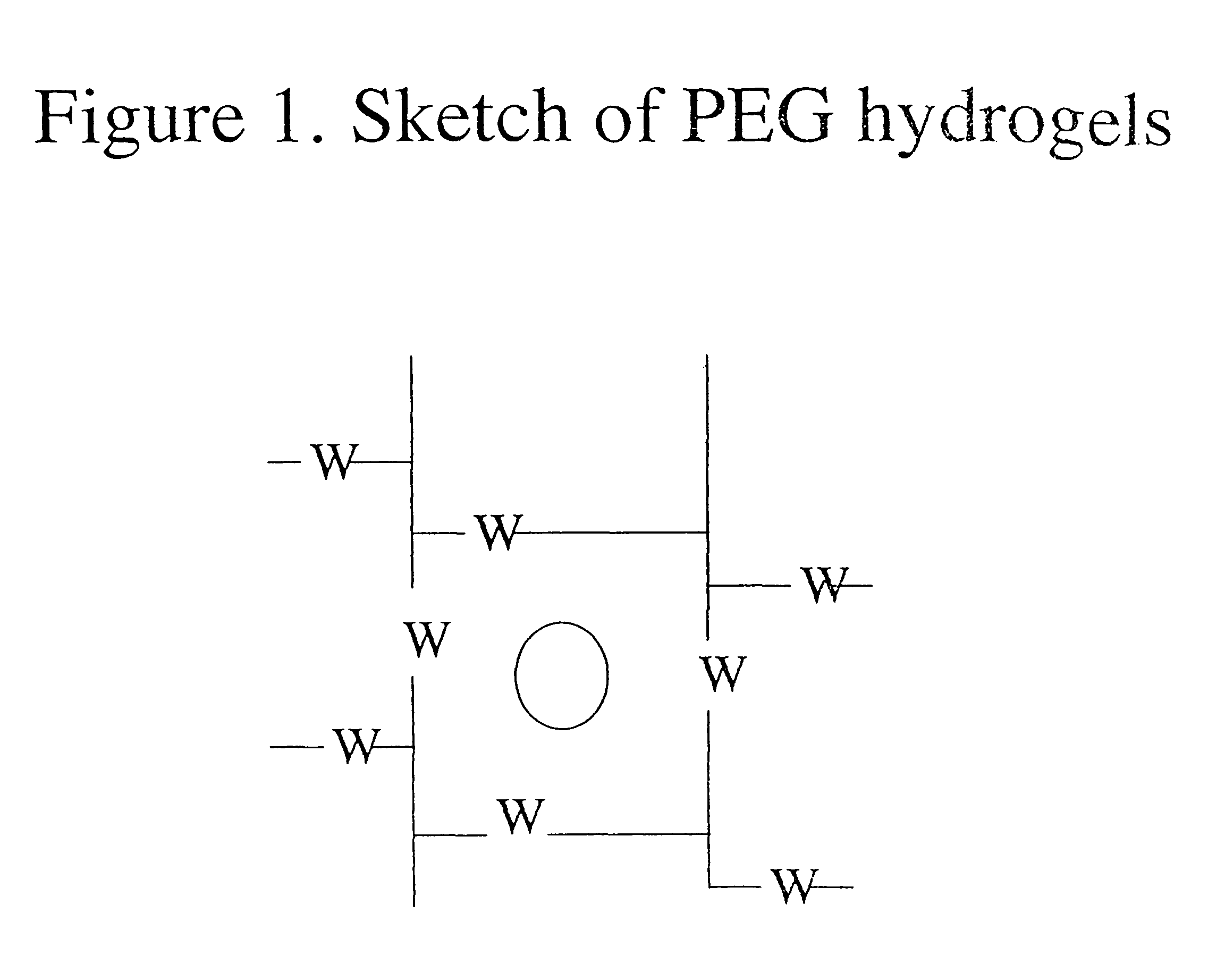Degradable poly(ethylene glycol) hydrogels with controlled half-life and precursors therefor
a technology of polyethylene glycol and half-life, which is applied in the direction of organic active ingredients, pharmaceutical delivery mechanisms, synthetic polymeric active ingredients, etc., can solve the problems of toxic or otherwise undesirable residues, undesirable immune responses, and art-induced problems
- Summary
- Abstract
- Description
- Claims
- Application Information
AI Technical Summary
Benefits of technology
Problems solved by technology
Method used
Image
Examples
example 1
[0063]Example 1 shows preparation of a degradable PEG hydrogel having a hydrolytically unstable ester linkage. In an aluminum pan of 1 inch diameter, difunctional PEG 2000 acid (600 mg, 0.6 mmole end groups, available from Shearwater Polymers in Huntsville, Ala.) and one equivalent of 8-arm PEG 10,000 (750 mg, Shearwater Polymers) were mixed with 30 mg stannous 2-ethylhexanoate (Sigma Chemical) and melted. PEG acids used included PEG carboxymethyl acid (-PEG-OCH2COOH), PEG propionic acid (-PEG-O—CH2CH2COOH), and PEG succinic acid (-PEG-OOCCH2CH2COOH). After a thin film of the melt covered the pan surface uniformly, the pan was heated under vacuum at 130° C. and 100 millitorr for 6-24 hours. A firm, transparent gel formed. After cooling in a N2 stream, the gel became translucent and was cut into thin disks and purified by the following procedures.
[0064]The crude gels were swollen in glacial acetic acid and washed three times with this solvent during a 2-3 days period. For hydrogels w...
example 2
[0065]Example 2 shows preparation of a degradable PEG hydrogel having a hydrolytically unstable imine linkage. In a test tube, difunctional PEG propionic aldehyde 3400 (100 mg, 58.8 μmole, Shearwater Polymers) and 8-arm PEG amine 10,000 (74 mg, 58.8 μmole) were dissolved in 1,4-dioxane (Aldrich Chemical). The test tube was heated on an oil bath at 70° C. for about two hours. The gel was then dried under reduced pressure at room temperature.
[0066]The PEG aldehydes used included PEG propionaldehyde (-PEG-OCH2CH2CHO), PEG acetaldehyde (-PEG-OCH2CHO), and PEG benzaldehyde (-PEG-O—C6H4—CHO).
[0067]Examples 3 and 4, below, show preparation of PEG derivatives having hydrolytically unstable linkages for use in preparing the degradable hydrogel of the invention.
example 3
[0068]Example 3 shows synthesis of PEG derivatives having hydrolytically unstable backbone linkages and NHS active carbonates at each terminus thereof. The PEG derivative can be represented as NHS—OOCO-PEG-W-PEG-OCOO—NHS where W represents the hydrolytically unstable linkage. In a 100 ml round-bottom flask, benzyloxy-PEG carboxymethyl acid 3400 (3.4 g, 1 mmol, Shearwater Polymers) in toluene was azeotropically distilled for two hours and then cooled to room temperature. A solution of thionyl chloride (2M, 4 ml, 8 mmole, Aldrich) in methylene chloride was injected and the mixture was stirred under N2 overnight. The solvent was condensed by rotary evaporation and the syrup was dried in vacuo for about four hours over P2O5 powder. To the residue was added anhydrous methylene chloride (5 ml) and azeotropically dried benzyloxy-PEG 3400 (2.55 g, 0.75 mmol) in toluene (20 ml). After the benzyloxy-PEG acyl chloride was dissolved, freshly distilled triethylamine (0.6 ml) was added. The mixtu...
PUM
| Property | Measurement | Unit |
|---|---|---|
| Time | aaaaa | aaaaa |
| Time | aaaaa | aaaaa |
| Structure | aaaaa | aaaaa |
Abstract
Description
Claims
Application Information
 Login to View More
Login to View More - R&D
- Intellectual Property
- Life Sciences
- Materials
- Tech Scout
- Unparalleled Data Quality
- Higher Quality Content
- 60% Fewer Hallucinations
Browse by: Latest US Patents, China's latest patents, Technical Efficacy Thesaurus, Application Domain, Technology Topic, Popular Technical Reports.
© 2025 PatSnap. All rights reserved.Legal|Privacy policy|Modern Slavery Act Transparency Statement|Sitemap|About US| Contact US: help@patsnap.com

